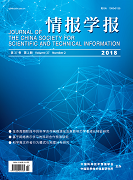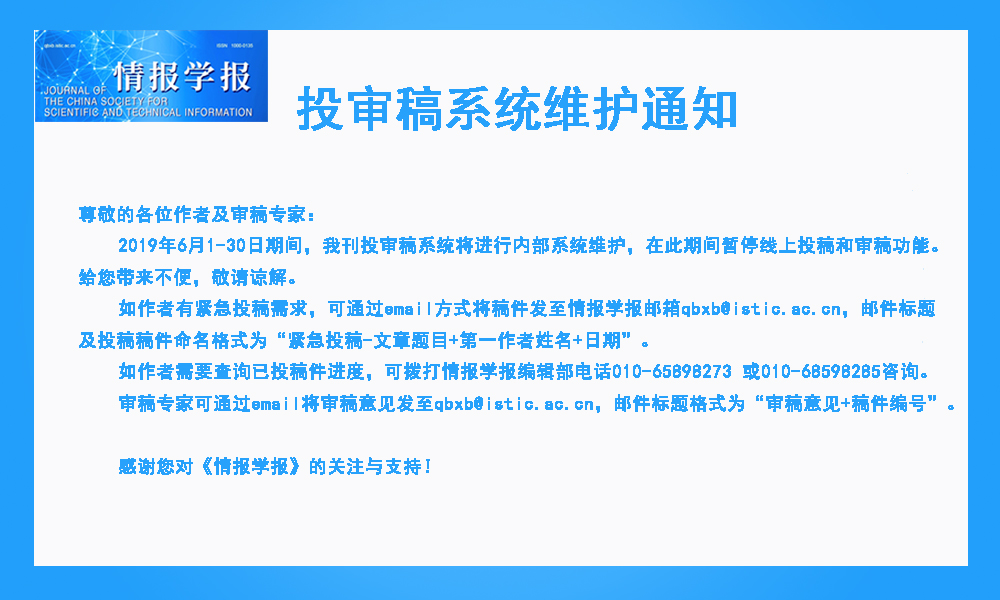 |
|
2018 Vol. 37, No. 2
Published: 2018-02-24 |
|
|
| |
|
|
|
|
|
121 |
Research on the Evolution of the Scientific Collaboration Network and the Growth of the High-Impact Author in the Life Cycle Phase |
|
 |
Wang Yuefen, Li Dongqiong, Yu Houqiang |
|
|
DOI: 10.3772/j.issn.1000-0135.2018.02.001 |
|
|
In order to further study scientific collaboration and reveal the law of scientific development, research on the evolution of the scientific collaboration network, especially of individual authors and component networks was conducted on the New Energy field of CNKI in China, based on the life cycle theory and by means of mathematical statistics and complex networks. Results show that except for the burgeoning phase, collaboration networks in the growing phase, booming phase, and transforming phase are scale-free networks and follow the power law distribution. Collaboration networks in each phase present different features. This study explores the growth characteristics of the top 10 high-impact scholars in the new energy field in different life cycle stages of the scientific collaboration network from three points of view: entering the collaboration pattern, the evolution model, and the network type of a high-impact author. Results show that the collaboration network in each phase presents distinctive features. Other important factors include the number of co-authors, whether the cooperation is with other high-impact authors, and the time interval when authors enter a new energy field. Four types of entering collaboration patterns are identified. Through the degree distribution of high-impact authors in different stages, four evolution patterns of individual high-impact authors are detected, namely a steadily growing pattern, growth and diminish pattern, keep leading pattern, and remain normal pattern. Three types of component networks are recognized, namely mobile collaboration component networks, leading growth collaboration component networks, and multiple core collaboration component networks. |
|
|
2018 Vol. 37 (2): 121-131
[Abstract]
(
312
)
HTML
(1 KB)
PDF
(1561 KB)
(
1024
) |
|
|
|
140 |
Study of Scientific Tweet Author’s Behavior Pattern and Geographic Distribution |
|
 |
Yu Houqiang, Wang Yuefen, Wang Feifei, Chen Bikun |
|
|
DOI: 10.3772/j.issn.1000-0135.2018.02.003 |
|
|
Statistical and visualization analyses were conducted on 2.63 million authors of 20.69 million scientific tweets, to reveal the authors’ behavior patterns including the number of scientific tweets, followed sources, and followed disciplines, as well as their geographic distribution at both a country and a city level. Results will provide reference for further understanding of the meaning of Twitter altmetrics and for future applications. Results show: (1) the distribution of authors’ productivity is highly skewed; 10% of the authors produced 80% of scientific tweets, and 91% of the authors tweeted no more than 10 scientific tweets. This means that most authors only occasionally disseminate and discuss academic products on Twitter. Meanwhile, there is a small percentage of extremely active authors. (2) Core sources that attract most authors, such as Nature, The Conversation and PLoS ONE, take up 6% of all publication sources and account for 77% of scientific tweets. Furthermore, 62% of authors follow only one source. (3) Disciplines that attract most authors are Medicine, General and Social Science, with 71% of authors following only 1 discipline while approximately 8% of authors follow over 3 disciplines. (4) Authors of scientific tweets are distributed all over the world, but are especially dense in USA and Europe. In East Asia, Japan is the most prominent country whereas in South America, Brazil is the most prominent. Authors are concentrated in cities like London and New York. These results show that Twitter altmetrics based on pure number of scientific tweets are not effective enough and future practical indicators need to combine author context as an important factor. |
|
|
2018 Vol. 37 (2): 140-150
[Abstract]
(
307
)
HTML
(1 KB)
PDF
(2413 KB)
(
882
) |
|
|
|
172 |
Design and Implementation of an Automatic Briefing System Based on the Work Thinking of Intelligence 3.0 |
|
 |
Liu Ru, Zhang Huina, Du Liping, Li Menghui, Wu Chensheng |
|
|
DOI: 10.3772/j.issn.1000-0135.2018.02.006 |
|
|
An automatic briefing system makes intelligence services more real-time、accurate、and personalized. Not only can it present valuable information, but it can also support the daily decision-making of managers and communication connections between the intelligence department and the decision-making level. An automatic briefing system plays an important role in improving the service quality of intelligence 3.0. In this paper, the framework of an automatic briefing system based on the work thinking of intelligence 3.0 is designed, a management system is constructed, an automatic briefing model is defined, and an automatic generating path is described. Lastly, through case studies of briefing from scientific papers, we summarize the automatic briefing service paradigm based on the work thinking of intelligence 3.0. |
|
|
2018 Vol. 37 (2): 172-182
[Abstract]
(
358
)
HTML
(1 KB)
PDF
(1772 KB)
(
1400
) |
|
|
|
183 |
Research on the Automatic Word Segmentation of The Book of Songs under Multi-dimensional Domain Knowledge |
|
 |
Wang Shanshan, Wang Dongbo, Huang Shuiqing, He Lin |
|
|
DOI: 10.3772/j.issn.1000-0135.2018.02.007 |
|
|
The Book of Songs is the earliest anthology of poetry in China: it is one of the thirteen classic books of Confucian tradition. The Book of Songs is ranked the first of the ancient canonical Five Classics. The Five Classics include Yijing (“Classic of Changes”), the Shujing (“Classic of History”), The Book of Songs, the Collection of Rituals, and the Chunqiu (“Spring and Autumn Annals”). The connotations of The Book of Songs are abundant, reflecting all aspects of social life in the Zhou Dynasty, such as labor and love, war and corvee oppression and rebellion, customs and marriage, ancestor worship and banquets, and even astronomy, geomorphology, animals, and plants. It is a mirror of Zhou Dynasty society, known as The Life Encyclopedia of Ancient Society. Moreover, The Book of Songs is the textbook of ancient Chinese political ethics, aesthetic education, and naturalism. With the extensive application of humanities computing, this paper combines the Sinological Index Series with the domain knowledge of the Mao Shi Index, and studies the automatic word segmentation of The Book of Songs using the machine learning method. Based on the corpus of the manual word segmentation of The Book of Songs, the method of combining the Guang Yun and statistical analysis was used to get 23 sets of feature templates that fuse different characteristics knowledge and then producing machine learning segmentation model by training. The performance of each word segmentation model is analyzed, and it is found that lexical features have the greatest influence on the word segmentation effect of The Book of Songs, and the harmonic mean F value of the word segmentation model can be up to 97.42%. Finally, the paper uses the domain glossary of the Mao Shi Index to carry out the post-processing of the long word correction with the test performance optimum segmentation model, and obtains the word corpus of The Book of Songs that fuses the expert vocabulary knowledge of the Mao Shi Index. This article integrates knowledge into the multi-dimensional domain to realize the automatic segmentation of The Book of Songs, which provides reference for the related research of the Pre-Qin poetry. Moreover, it inspires the study of the automatic word segmentation of Pre-Qin Classics. The word corpus of The Book of Songs, as part of the Pre-Qin Classics word corpus, has a supporting role to further realize the knowledge mining of the Pre-Qin Classics. |
|
|
2018 Vol. 37 (2): 183-193
[Abstract]
(
361
)
HTML
(1 KB)
PDF
(872 KB)
(
900
) |
|
|
|
194 |
Deep Neural Networks Language Model Based on CNN and LSTM Hybrid Architecture |
|
 |
Wang Yi, Xie Juan, Cheng Ying |
|
|
DOI: 10.3772/j.issn.1000-0135.2018.02.008 |
|
|
The language model is one of the most important domains in natural language processing. It is a bridge for the computer to identify and comprehend human language, and it is also a sign of Artificial Intelligence development. The language model is popular in Speech Recognition, Machine Translation, Information Retrieval, and Knowledge Mapping. With the rapid expansion of technology and hardware, the language model has experienced a transformation from statistical model to neural network model and then to the deep neural network model. The wide application of depth learning makes language modeling more extensive, complex, and expensive. This paper combines the personalized input, convolutional neural network (CNN) coding, and the technique of union gate, cooperating with long short-term memory (LSTM) mechanism to improve the language model. The dynamic integration of LSTM and CNN is called Gated CLSTM. In the experiment, we used the deep learning framework Tensorflow to achieve a Gated GLSTM architecture. Besides, some classical optimization techniques, such as noise contrastive estimation and recurrent projection layer, were adopted in the experiment. We tested the performance of the Gated CLSTM under an open and big scale corpus set and trained a signal-layer model and a three-layer model to observe how network depth influences the performance. The single-layer model has 4 days of training experience and reduced the perplexity to 42.1 in four GPU console environment. The three-layer model reduced the perplexity to 33.1 in 6 days. Compared with some classical benchmark models, significant improvements have been made by Gated CLSTM considering both hardware and time complexity and perplexity. |
|
|
2018 Vol. 37 (2): 194-205
[Abstract]
(
384
)
HTML
(1 KB)
PDF
(1368 KB)
(
3788
) |
|
|
|
220 |
A Review on the Search Engine Result Page (SERP) |
|
 |
Wu Dan, Tang Yuan |
|
|
DOI: 10.3772/j.issn.1000-0135.2018.02.010 |
|
|
This paper uses synthesis methods to examine foreign conference and journal articles that study search engine result page (SERP), and analyzes the research progress in this field. With respect to the research available on the layout design of SERPs, the results show that since the modern search engine aggregates the various types of information resources, the SERP is vertical and diversified in nature, and the embedded elements of the SERP affect the user’s satisfaction, attention, experience and evaluation of the SERP; on the other hand, using user-behavior data that includes eye movement, cursor movement, gestures, acoustics and other interactive data, it is possible to analyze the user-fixation areas and attention-distribution characteristics of the SERP to establish a user-attention prediction model, and to predict user intentions, attention, and the results of bias. Future directions mentioned in the literature include SERP layout design research extending to voice interaction, social networking, and other related fields, as well as more comprehensive interactive data support for user-seeking behavior modeling and attention prediction. |
|
|
2018 Vol. 37 (2): 220-230
[Abstract]
(
201
)
HTML
(1 KB)
PDF
(1736 KB)
(
1153
) |
|
|
|


